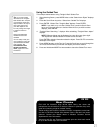
19
Which One’s the Alignment Star?
If you’re not familiar with objects in the night sky, how can you be sure if the star
in your eyepiece is really the alignment star?
The rule of thumb is that an alignment star is usually the brightest star in that
area of the sky. If you perform a GO TO to an alignment star and you're not sure
if you have located the alignment star or it isn't in the eyepiece, look through your
viewfinder. When you view an alignment star in the viewfinder, it stands out
dramatically from the rest of the stars in that portion of the sky. The viewfinder
will help you locate a star more quickly than the eyepiece, because it has a much
wider field of view than the eyepiece. Using Autostar, set the slew speed to 6
(push Number key 6) or higher and use the Arrow keys to center the alignment
star in the viewfinder. If your viewfinder has been aligned with the telescope, the
alignment star should now be in the eyepiece. Set the slew speed to 4 or less
and center the star in the eyepiece. Also see the
SPIRAL SEARCH tip, page 20.
ETX TIPS
Important Note: Before aligning the telescope, you MUST first initialize
Autostar, as described in
INITIALIZING AUTOSTAR, page 18. See MOVING
THROUGH AUTOSTAR’S MENUS, page 17, for a description of how
Autostar’s keys operate.
How to perform the Easy Align Procedure
If you have just performed the initialization procedure, go to step 6.
1. Sun Warning: Press the key prompted by Autostar to accept.
2.
Getting Started: Press ENTER to continue.
3. Enter Date: Enter the current date, then press ENTER.
4. Enter Time: Enter the current time. Select "AM," "PM," or 24-hour clock (blank).
Then press ENTER.
5.
Daylight Savings: Select “Yes” or “No,” then press ENTER.
6. Alignment Option Screen: “Setup: Align” displays. Press ENTER.
7. Select Alignment: “Align: Easy” displays. Press ENTER.
8. Set Home Position: Autostar then prompts you to set the telescope in the Alt/Az
Alignment home position (if necessary). To set your telescope in the "Alt/Az"
home position:
• Loosen the telescope’s vertical lock (
6, Fig. 1).
• Level the tripod head. See Step #3g, page 12. Level the optical tube by
lining up 0° on the Dec setting circle (
16, Fig. 1) with the Dec pointer
(the small molded triangle under the setting circle).
• Retighten the vertical lock (6, Fig. 1) to a firm feel only.
• Unlock the horizontal lock (9, Fig. 1).
• Grasp the telescope by a fork arm and rotate the telescope counterclockwise
until it stops.
• Turn the telescope clockwise until a fork arm is directly over the computer
control panel.
• Re-lock the R.A. lock (
9, Fig. 1).
• Lift and rotate the telescope and tripod until they point North. Press ENTER.
See LOCATING THE CELESTIAL POLE, page 53 for more information.
9 . Star Alignment: Autostar chooses two stars to align upon. When the telescope
slews to the first star for alignment, it may not appear in the field of view in the
eyepiece. Try to locate the star using the viewfinder (
2, Fig. 1). The alignment star
should be easily recognized and be the brightest star in the area of the sky where
the telescope is pointing. Look through the viewfinder and use the Arrow keys to
move the telescope until the star is visible. Then center the star in the eyepiece.
Press ENTER. Repeat the procedure for the second alignment star.
Important Note:
The first time you use
your telescope or if you
are experiencing any
problems with pointing
accuracy, follow the
procedure described in
APPENDIX C:TRAINING
THE DRIVE
, page 56, to
insure accurate pointing
and tracking.
Tip:
The GO TO key also
allows you to perform a
"
spiral search." A spiral
search is useful when the
telescope slews to an
object, but that object is
not visible in the eyepiece
after the telescope
finishes its search. (This
sometimes occurs during
an alignment procedure.)
Press GO TO when the
telescope stops slewing.
The telescope begins to
move in a spiral pattern at
a very slow speed around
the search area. Look
through the
eyepiece and when the
object does become
visible, press MODE to
stop the spiral search.
Then use the Arrow keys
to center the object.


















